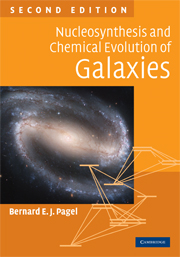Book contents
- Frontmatter
- Contents
- List of abbreviations
- Preface to the first edition
- Preface to the second edition
- 1 Introduction and overview
- 2 Thermonuclear reactions
- 3 Cosmic abundances of elements and isotopes
- 4 Cosmological nucleosynthesis and abundances of light elements
- 5 Outline of stellar structure and evolution
- 6 Neutron capture processes
- 7 Galactic chemical evolution: basic concepts and issues
- 8 Some specific GCE models and related observational data
- 9 Origin and evolution of light elements
- 10 Radioactive cosmochronology
- 11 Chemical evolution in other sorts of galaxies
- 12 Cosmic chemical evolution and diffuse background radiation
- Appendix 1 Some historical landmarks
- Appendix 2 Some physical and astronomical constants
- Appendix 3 Time-dependent perturbation theory and transition probabilities
- Appendix 4 Polytropic stellar models
- Appendix 5 Dissipation and abundance gradients
- Appendix 6 Hints for problems
- References
- Index
12 - Cosmic chemical evolution and diffuse background radiation
Published online by Cambridge University Press: 05 June 2012
- Frontmatter
- Contents
- List of abbreviations
- Preface to the first edition
- Preface to the second edition
- 1 Introduction and overview
- 2 Thermonuclear reactions
- 3 Cosmic abundances of elements and isotopes
- 4 Cosmological nucleosynthesis and abundances of light elements
- 5 Outline of stellar structure and evolution
- 6 Neutron capture processes
- 7 Galactic chemical evolution: basic concepts and issues
- 8 Some specific GCE models and related observational data
- 9 Origin and evolution of light elements
- 10 Radioactive cosmochronology
- 11 Chemical evolution in other sorts of galaxies
- 12 Cosmic chemical evolution and diffuse background radiation
- Appendix 1 Some historical landmarks
- Appendix 2 Some physical and astronomical constants
- Appendix 3 Time-dependent perturbation theory and transition probabilities
- Appendix 4 Polytropic stellar models
- Appendix 5 Dissipation and abundance gradients
- Appendix 6 Hints for problems
- References
- Index
Summary
…that a telescope with a power of penetrating into space, like my 40-feet one, has also, it may be called, a power of penetrating into time past. To explain this, we must consider that, from the known velocity of light, it may be proved, that when we look at Sirius, the rays which enter the eye cannot have been less than 6 years and 4½ months coming from that star to the observer. Hence it follows, that when we see an object of the calculated distance at which one of these very remote nebulae may still be perceived, the rays of light which convey its image to the eye, must have been more than nineteen hundred and ten thousand, that is, almost two millions of years on their way; and that, consequently, so many years ago, this object must already have had an existence in the sidereal heavens, in order to send out those rays by which we now perceive it.
William Herschel, Catalogue of 500 new Nebulae, nebulous stars, planetary Nebulae, and Clusters of Stars; with Remarks on the Construction of the Heavens, Phil. Trans. XCII (1802), 477.Introduction
Observations of distant objects, notably high-redshift star-forming (‘Lymanbreak’) galaxies and absorption line systems on the line of sight to quasars, give some information on chemical evolution at epochs not too far from when the first stars and most galaxies were presumably formed.
- Type
- Chapter
- Information
- Nucleosynthesis and Chemical Evolution of Galaxies , pp. 374 - 398Publisher: Cambridge University PressPrint publication year: 2009

